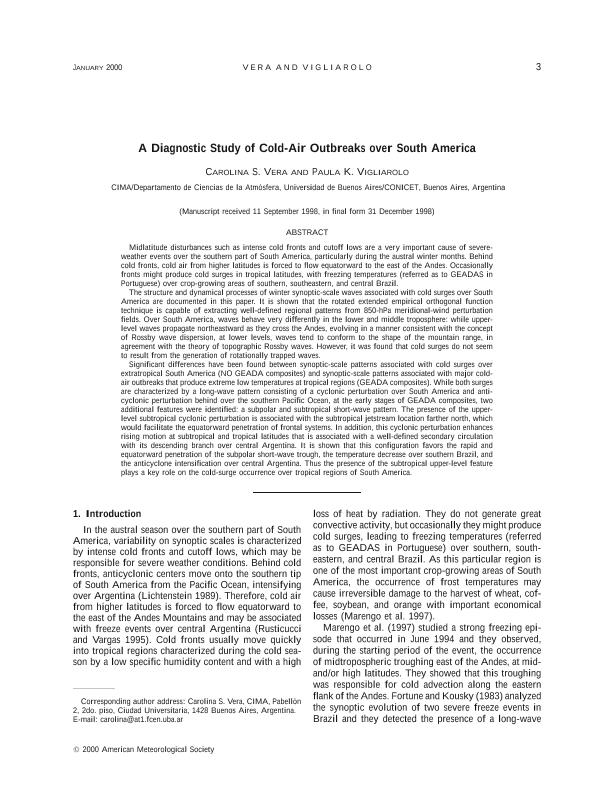Artículo
A Diagnostic Study of Cold-Air Outbreaks over South America
Fecha de publicación:
01/2000
Editorial:
Amer Meteorological Soc
Revista:
Monthly Weather Review
ISSN:
0027-0644
e-ISSN:
0027-0644
Idioma:
Inglés
Tipo de recurso:
Artículo publicado
Clasificación temática:
Resumen
Midlatitude disturbances such as intense cold fronts and cutoff lows are a very important cause of severeweather events over the southern part of South America, particularly during the austral winter months. Behind cold fronts, cold air from higher latitudes is forced to flow equatorward to the east of the Andes. Occasionally fronts might produce cold surges in tropical latitudes, with freezing temperatures (referred as to GEADAS in Portuguese) over crop-growing areas of southern, southeastern, and central Brazil. The structure and dynamical processes of winter synoptic-scale waves associated with cold surges over South America are documented in this paper. It is shown that the rotated extended empirical orthogonal function technique is capable of extracting well-defined regional patterns from 850-hPa meridional-wind perturbation fields. Over South America, waves behave very differently in the lower and middle troposphere: while upperlevel waves propagate northeastward as they cross the Andes, evolving in a manner consistent with the concept of Rossby wave dispersion, at lower levels, waves tend to conform to the shape of the mountain range, in agreement with the theory of topographic Rossby waves. However, it was found that cold surges do not seem to result from the generation of rotationally trapped waves. Significant differences have been found between synoptic-scale patterns associated with cold surges over extratropical South America (NO GEADA composites) and synoptic-scale patterns associated with major coldair outbreaks that produce extreme low temperatures at tropical regions (GEADA composites). While both surges are characterized by a long-wave pattern consisting of a cyclonic perturbation over South America and anticyclonic perturbation behind over the southern Pacific Ocean, at the early stages of GEADA composites, two additional features were identified: a subpolar and subtropical short-wave pattern. The presence of the upperlevel subtropical cyclonic perturbation is associated with the subtropical jetstream location farther north, which would facilitate the equatorward penetration of frontal systems. In addition, this cyclonic perturbation enhances rising motion at subtropical and tropical latitudes that is associated with a well-defined secondary circulation with its descending branch over central Argentina. It is shown that this configuration favors the rapid and equatorward penetration of the subpolar short-wave trough, the temperature decrease over southern Brazil, and the anticyclone intensification over central Argentina. Thus the presence of the subtropical upper-level feature plays a key role on the cold-surge occurrence over tropical regions of South America.
Palabras clave:
Cold-Air Outbreaks
,
South America
,
frost
,
synoptic-scale waves
Archivos asociados
Licencia
Identificadores
Colecciones
Articulos(CIMA)
Articulos de CENTRO DE INVESTIGACIONES DEL MAR Y LA ATMOSFERA
Articulos de CENTRO DE INVESTIGACIONES DEL MAR Y LA ATMOSFERA
Citación
Vera, Carolina Susana; Vigliarolo, Paula Karina; A Diagnostic Study of Cold-Air Outbreaks over South America; Amer Meteorological Soc; Monthly Weather Review; 128; 1; 1-2000; 3-24
Compartir
Altmétricas




